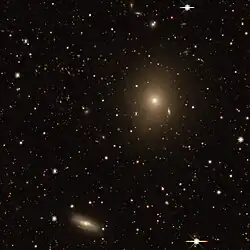| NGC 7002 | |
|---|---|
 NGC 7002 (top) and NGC 7004 (bottom) with legacy survey | |
| Observation data (J2000 epoch) | |
| Constellation | Indus |
| Right ascension | 21h 03m 44.8s[1] |
| Declination | −49° 01′ 47″[1] |
| Redshift | 0.024520[1] |
| Heliocentric radial velocity | 7351 km/s[1] |
| Distance | 319,349,800 ly |
| Apparent magnitude (V) | 13.46[1] |
| Characteristics | |
| Type | E1 pec[1] |
| Apparent size (V) | 1.5 × 1.2[1] |
| Other designations | |
| ESO 235-43, PGC 66009[1] | |
NGC 7002 is a large elliptical galaxy around 320 million light-years away from Earth in the constellation of Indus.[2][3] The galaxy was discovered by English astronomer John Herschel on September 30, 1834.[4] NGC 7002 is also part of a group of galaxies that contains the nearby galaxy NGC 7004.[5]
See also
- IC 1101, A massive elliptical galaxy which is also one of the largest known galaxies.
- M87, A large and famous large elliptical galaxy about 50 mly in the constellation Virgo.
- List of NGC objects (7001–7840)
References
- 1 2 3 4 5 6 7 8 "NASA/IPAC Extragalactic Database". Results for NGC 7002. Retrieved 2017-04-15.
- ↑ Rojas, Sebastián García. "Galaxy NGC 7002 Deep Sky Objects Browser". DSO Browser. Archived from the original on 2017-05-24. Retrieved 2017-04-15.
- ↑ "Your NED Search Results". ned.ipac.caltech.edu. Retrieved 2017-04-16.
- ↑ "New General Catalog Objects: NGC 7000 – 7049". cseligman.com. Retrieved 2017-04-15.
- ↑ "NGC 7004". simbad.u-strasbg.fr. Retrieved 2017-06-22.
External links
 Media related to NGC 7002 at Wikimedia Commons
Media related to NGC 7002 at Wikimedia Commons- NGC 7002 on WikiSky: DSS2, SDSS, GALEX, IRAS, Hydrogen α, X-Ray, Astrophoto, Sky Map, Articles and images
This article is issued from Wikipedia. The text is licensed under Creative Commons - Attribution - Sharealike. Additional terms may apply for the media files.